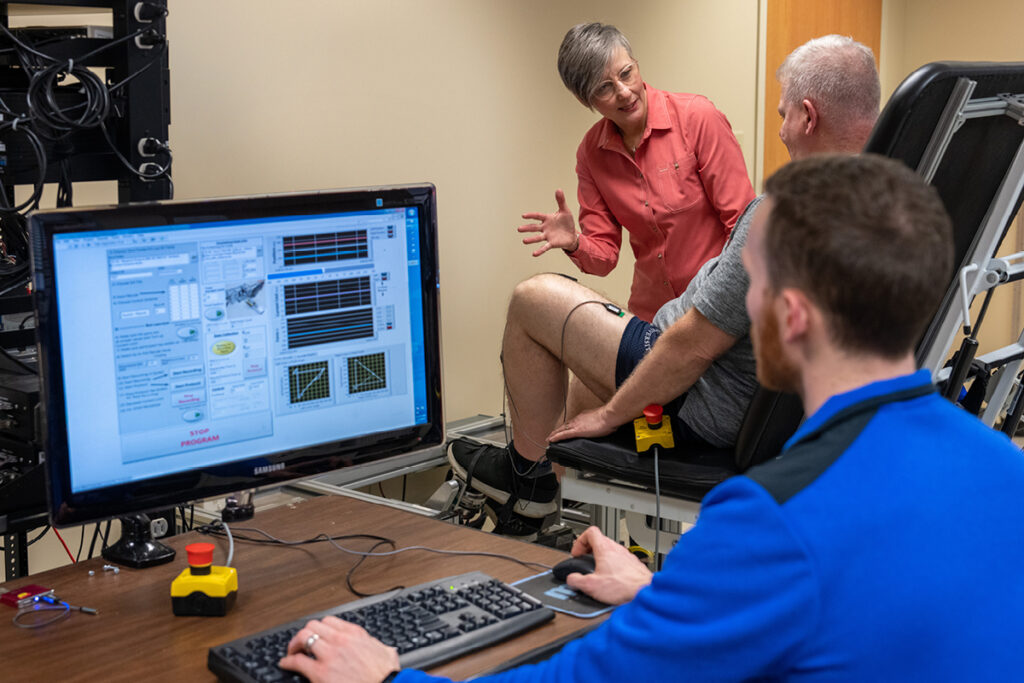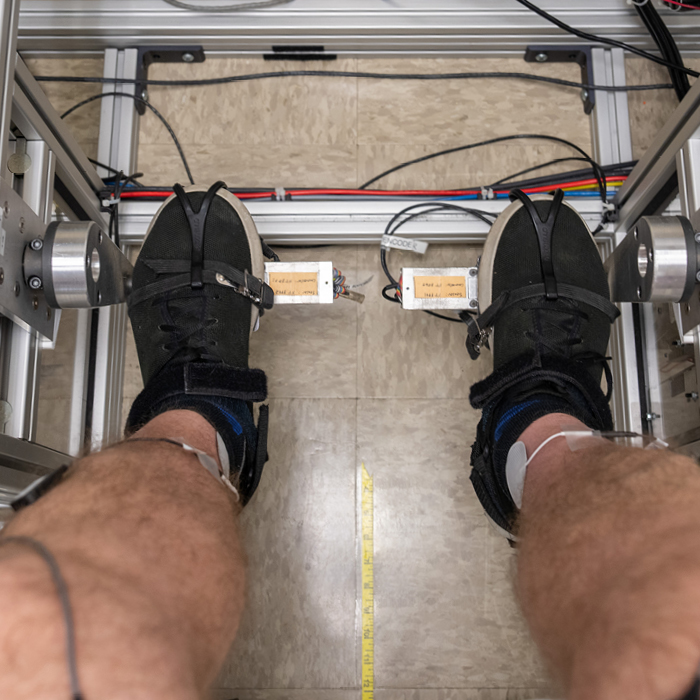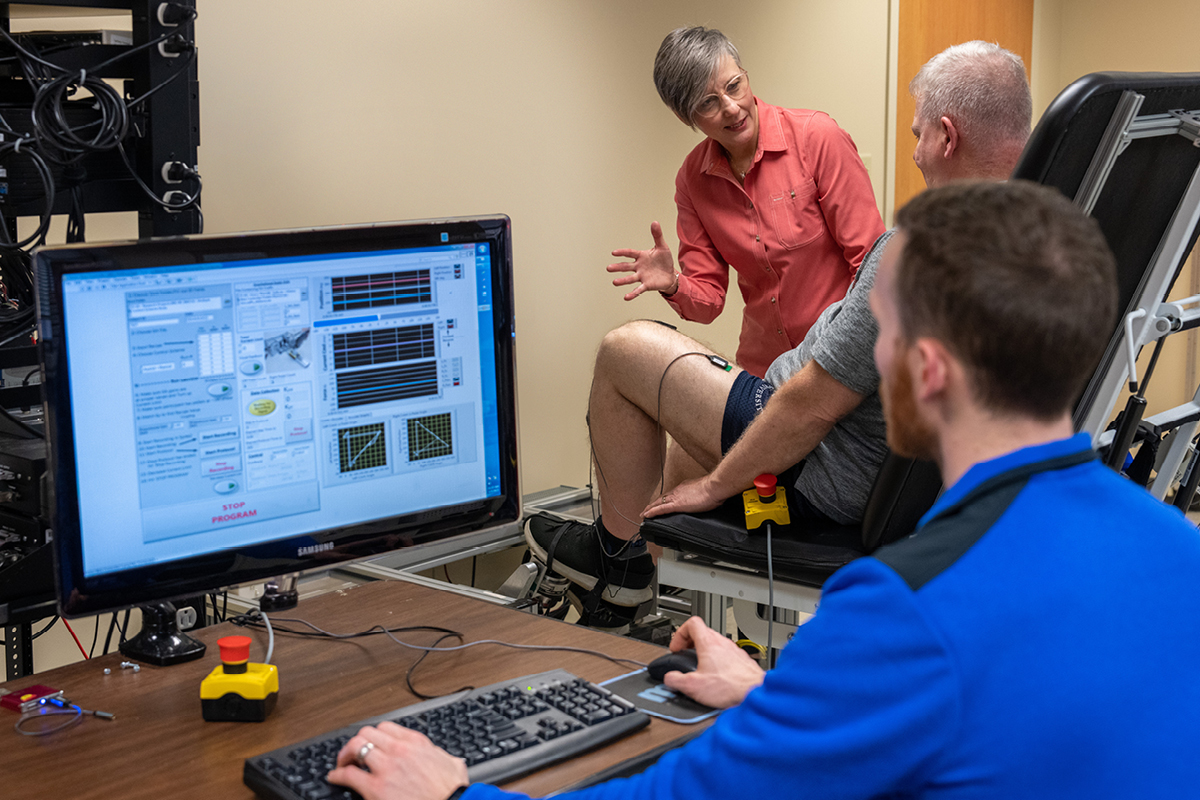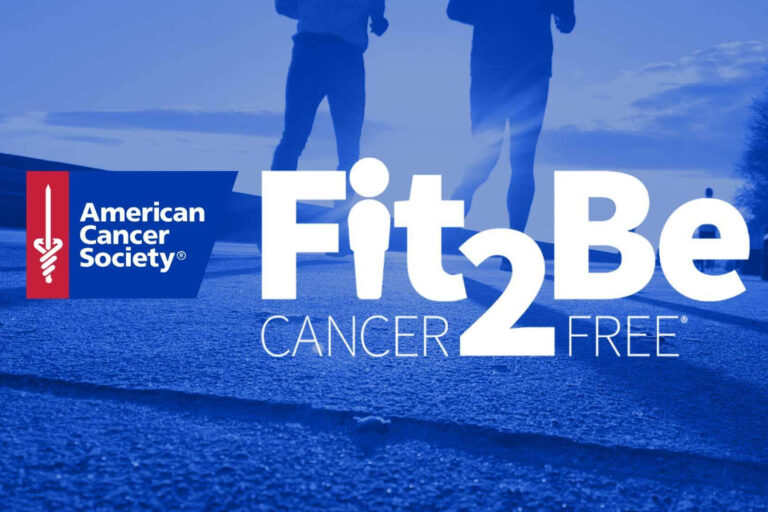
Physical Therapy Professor Dr. Sheila Schindler-Ivens had the idea of creating a pedal trainer that delivers customized resistance to a stroke patient’s paretic leg. The device is now patented and on track for commercialization that could help physical therapists dramatically improve mobility for stroke patients.
By Tracy Staedter
For most of her early career, Dr. Sheila Schindler-Ivens, PT ’89, was satisfied conducting research to better understand movement disorders in people who’ve had a stroke. She didn’t see her research leading to a practical application and that was OK. She was finding inspiration in the way the human body worked.

But then around 2014, something changed. Schindler-Ivens, associate professor of physical therapy, and her research team invented a pedaling device with a split crank shaft that allowed a person to cycle each leg independent of the other. Experiments she conducted with the device completely toppled assumptions at the time about stroke patients who had a paretic leg — that they needed to depend on the stronger leg for rehabilitation. It turned out that the weaker leg had more muscle function than previously thought and could get much stronger if given the chance to pedal without depending on the stronger leg.
It was a revelation to Schindler-Ivens. She realized that if the device was commercialized, physical therapists everywhere could dramatically improve the mobility of thousands of stroke patients and at the same time reduce the physically demanding treatments therapists undertake to achieve the best outcomes.
Suddenly Schindler-Ivens was thrust into the world of entrepreneurship. She and two of her colleagues from Marquette University, Biomedical Engineering received four patents on the device, and Schindler-Ivens formed the company Venus Rehabilitation Technologies. In 2019 and 2020, Schindler-Ivens participated in commercialization fellowships designed to help her bring the technology to market. Whether she was ready or not, her lab work was making its way to application.
“You don’t get these chances every day,” she says.

No Control
Schindler-Ivens’s discovery started with an experiment to better understand how a person’s brain is reorganized after a stroke to control leg movement. She and her research team built an assistive lower limb rehabilitation pedaling device with a split crank shaft that allowed a study participant to lie down and pedal each leg independently of the other. Having patients pedal with their head inside an MRI machine allowed researchers to measure brain activity.
Surprisingly, when asked to pedal using the weaker, paretic leg alone, most participants had more muscle function and brain activation than was expected. It meant that there was potential to train the leg to get stronger. But when asked to pedal with both legs and maintain a 180-degree relationship between the two legs, the pedaling became jerky and erratic.
“It’s when they have to coordinate with the other leg that the wheels come off, so to speak,” says Schindler-Ivens.
The study showed that stroke patients needed to be compelled to use their paretic leg — not only independently of the stronger leg but in coordination with it. They named the prototype device CUped — which stands for compels use of paralyzed limbs during a movement that resembles pedaling. If commercialized, CUped could give clinicians the right therapeutic tool for this job.
Opening Doors
Originally, Schindler-Ivens bristled at the idea of starting a business. How could she run a company and still do research and teach her classes? “It wasn’t my interest, the business end of things,” she says.
But Kalpa Vithalani, Marquette’s executive director of technology transfer, convinced Schindler-Ivens that starting a company would open doors to funding and product development. One of those doors was marked “TREAT,” which stood for the National Institutes of Health’s Center for Translation of Rehabilitation Engineering Advances and Technology. As a recipient of its commercialization cohort award, which Schindler-Ivens received twice, she learned how to pitch her technology in a few minutes, create a business plan, identify her market and more.
Through dozens of interviews with physical therapists, she found that many of them put their own physical health at risk when treating their patients. For instance, one therapeutic exercise involves suspending a patient in a harness over a treadmill to allow them to practice walking. Some physical therapists hold the patient’s body and move their legs. It’s physically demanding and poses a risk for injury. It started to become clear that CUped could not only help a patient with rehab, it could also relieve the therapist of strenuous work.
She found that many of them put their own physical health at risk when treating their patients… It started to become clear that CUped could not only help a patient with rehab, it could also relieve the therapist of strenuous work.
This past October, Schindler-Ivens took her device and commercialization know-how to the 2022 Healthcare Innovation Pitch competition and received the inaugural Emerging Company award from the Accelerating Medical Product Development group of Southeast Wisconsin’s Clinical and Translational Science Institute. She won $5,000, which will go toward optimizing the algorithms that control CUped’s motors. Although she hasn’t yet received the capital investment she needs to bring CUped to market, she says she’s committed to playing it out.
“It is the culmination of everything I’ve studied and researched, and it might be the only impactful and a frontline-level thing I’ll ever discover,” says Schindler-Ivens.




